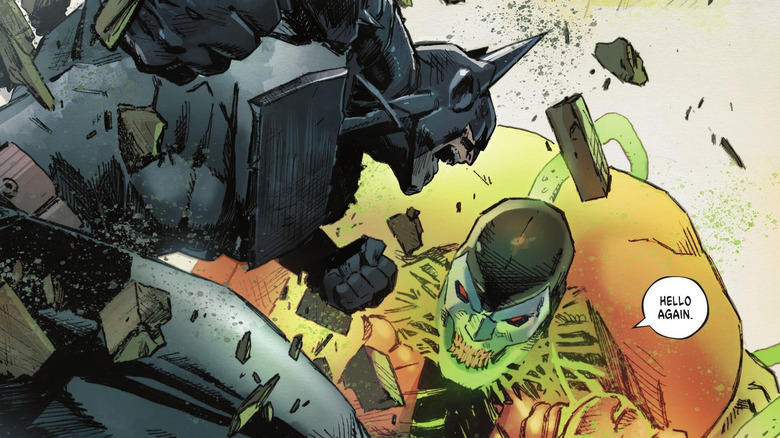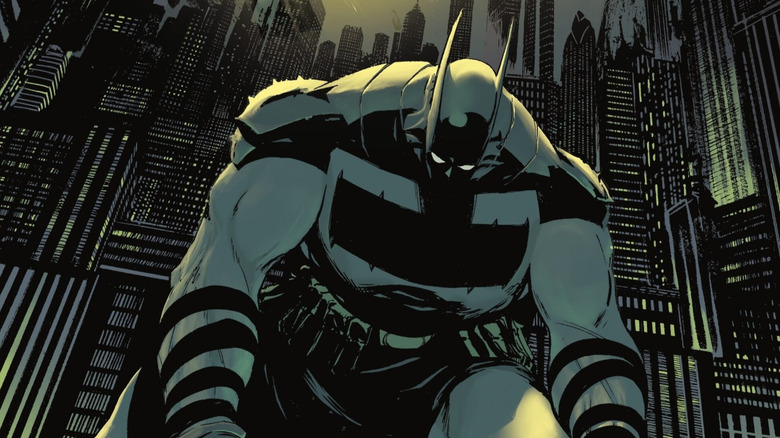Absolute Batman #11 Introduced The Most Terrifying Bane Yet
We may receive a commission on purchases made from links.
Spoilers for "Absolute Batman" follow.
The electrifying first arc of Scott Snyder and Nick Dragotta's "Absolute Batman" comic ended on a positive enough note. Batman, with the help of his friends, managed to defeat Roman Sionis/Black Mask and his Party Animals gang, who were besieging Gotham City. But Sionis was just a small fish in a big pond... and so too is Batman. This Bruce Wayne is a working class city engineer. He's got the strength and intelligence of his classic self, but not the easy-to-come-by resources.
At the end of "Absolute Batman" #6, Sionis' master — a mirthless billionaire serial killer ironically called "the Joker" — has seen his plans for Gotham hit a speed bump. His bat problem has proven to be no laughing matter, so he's going to send in a more serious exterminator. The Joker ends the issue with two words that send dread through the body of every Bat-fan reading: "Get Bane."
Bane is easy to mock when you've only got Tom Hardy's cheery-voiced Bane in "The Dark Knight Rises" in mind. Lest we forget, though, he is the man who broke the Bat (in the "Knightfall" comic storyline). And that's just the classic Bane — how monstrous could he be in the twisted Absolute universe? Quite, it turns out.
This Bane stands about nine feet tall when he's not using his Venom steroid, and can buff up to the size of a small building when he is. In "Absolute Batman" #9, Bane broke Batman without exerting the slightest effort or losing any bit of his calm. In "Absolute Batman" #10 he plays prison guard, keeping Bruce locked up for months in the Joker's "Ark M" house of horrors and mad science. Now, "Absolute Batman" #11 (drawn by fill-in artist Clay Mann) debuts the origin of Absolute Bane.
"Absolute Batman" hasn't been shy about drastically changing Batman staples, from rewriting Bruce Wayne's origin story to revamping Mr. Freeze into a lanky and ghoulish ice monster. Bane, though, has been pretty classic. He's got the skull-like luchador mask, green Venom tubes affixed to his head and arms, etc. His origin, too, is pulled right out of Bane's debut comic: 1993's "Vengeance of Bane" by writer Chuck Dixon and artist Graham Nolan.
Like his original self, Absolute Bane hails from the fictional South American country Santa Prisca, where he was raised in the prison Peña Duro for the sins of his revolutionary father. Inside, he endured and became a monster of a man. Snyder, though, recontextualizes Bane's history into that of this new world, molding him into a mirror image of what Batman might become.
Absolute Bane wants to break Batman... and then rebuild him
"Absolute Batman" #11 is narrated by Alfred (who is still an MI6 agent here), recounting what he's heard of Bane's history and all the warnings he should have given Bruce about him. Alfred imagines the two coming to blows; with Batman's own Bat-shaped axe, Bane hacks off Bruce's arms and bashes his head to pulp. The Batman, and his symbol, are broken.
It's only a fantasy sequence, but the action and gore is so painfully realized that it feels real. By this point we've seen Bane in action, too, and know Batman is facing a losing battle against him. But breaking the Bat is only half of Bane's mission.
This Bane was raised by his father and spent his earliest years living as a paramilitary in Santa Prisca. Eventually, their rebel group the Cielos Libres won... for three days, until the rebellion was utterly crushed by international troops. Bane and his father spent eleven years in prison with their comrades; Bane's father was sustained by a vision of Santa Prisca's national bird, the royal quetzal, flying free. Bane's black and white mask? It's made out of the Santa Prisca flag, itself adorned by the quetzal. Bane could never see this vision ... so when the Joker made him an offer of paradise on Santa Prisca in exchange for his soul, Bane took it and murdered his father.
The issue's narration leans hard on the parallels between Bane and Batman; the latter loves and protects Santa Prisca just as Bruce does Gotham. Bane's goal is to convince Batman that fighting against power is a doomed struggle, and he can only save Gotham by bowing his head to evil.
Bane has always been a dark mirror of Batman. Both were cast down in despair as children and reborn into Übermenschen through determination. Locked up in Peña Duro, Bane trained himself to athletic perfection and feasted on knowledge in many subjects, just as Bruce Wayne did while traveling the world. In 2017's "Batman" #19 by Tom King and David Finch, Bane tears his way through Arkham Asylum; he too can defeat all of Batman's greatest enemies.
Since his earliest appearances, Bane's threat comes not just from his super strength, but his strategic genius. He's a smart fighter, the way Batman is. "Absolute Batman" remembers that and adds a new layer to Venom; it doesn't just make Bane's muscles grow, it grants him precise control over them at a cellular level. He can even expand his brain to retain more knowledge, and is thus a walking encyclopedia of battle tactics.
Absolute Batman proves the Dark Knight is best as an underdog
Bane has traditionally sought to defeat Batman to prove he is indeed greater than him. In "Absolute Batman," Bane is absolutely greater than Batman, which makes fighting him seem hopeless. But Batman doesn't surrender hope, even backed against a wall.
Bane's ultimate vision for Bruce is to turn Batman into another Venom-powered warrior. Their battle is Bane's way of testing if Bruce has the mettle to survive the procedure. Alfred, imagining what this Batman would look like, describes him as "the hero Gotham needs." With that turn of phrase, the comic is quoting Christopher Nolan's Batman movie masterpiece, "The Dark Knight." It's not the first time the book has done so to offer up its own answer to who that hero is. In "The Dark Knight," the Joker (Heath Ledger) burns the Gotham mob's money to show that, for him, crime isn't all about the Benjamins: "It's about sending a message." Back in "Absolute Batman" #5, Bruce pretended to take a $200 million bribe from Black Mask to let the Party Animals be. Once Batman got the money, he burned it, using the flame to light up a Bat-signal in the sky.
When the Joker destroyed the money it was a sign of madness, but when Batman does it, the flames show he can't be corrupted. When discussing how he set out to reimagine Batman, Snyder said that while the traditional Batman represents order, Absolute Batman is chaos. Anyone can see right now that the systems that run the world are rotten, so a hero of the moment has to be one who works outside them.
But even on a narrative, monthly issue basis, an underdog hero makes for a more compelling story. A master crimefighter Batman who has everything under control is comforting, but a Batman dogged by ruthless and more powerful foes is thrilling. Snyder's most enduring Batman influence is Frank Miller's classic "The Dark Knight Returns," and this was apparently one of the lessons he learned from it. (In that book, Batman is branded an outlaw, hunted by the police and ultimately the U.S. government.)
Conversely, the Joker as a megalomaniacal billionaire makes him a much more potent evil for right now than if he were just another crazy clown. We've gotten few glimpses of the Absolute Joker thus far, but the scariest thing about him and what he represents is how he brought Bane, who is as strong and smart as a dozen men, to his knees.
"Absolute Batman" issues #1-11 are available for purchase; issue #12 is scheduled to be published on September 10.



